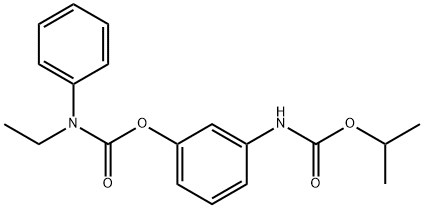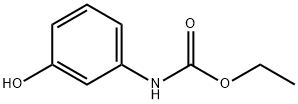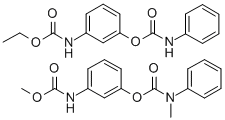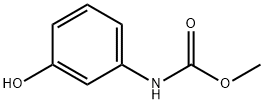[3-[[(Phenylamino)carbonyl]oxy]phenyl]carbamic acid ethyl ester
- CAS NO.:13684-56-5
- Empirical Formula: C16H16N2O4
- Molecular Weight: 300.31
- MDL number: MFCD00055462
- EINECS: 237-198-5
- SAFETY DATA SHEET (SDS)
- Update Date: 2024-12-18 14:07:02
![[3-[[(Phenylamino)carbonyl]oxy]phenyl]carbamic acid ethyl ester Structural](https://img.chemicalbook.in/CAS/GIF/13684-56-5.gif)
What is [3-[[(Phenylamino)carbonyl]oxy]phenyl]carbamic acid ethyl ester?
Chemical properties
Colorless, crystalline solid.
The Uses of [3-[[(Phenylamino)carbonyl]oxy]phenyl]carbamic acid ethyl ester
[3-[[(Phenylamino)carbonyl]oxy]phenyl]carbamic acid ethyl ester is a carbanilate based herbicide used in the weed control programs in sugar beet.
The Uses of [3-[[(Phenylamino)carbonyl]oxy]phenyl]carbamic acid ethyl ester
Selective systemic herbicide used to control broad-leaved weeds such as buckwheat, chickweed, fiddleneck, kochnia, mustard, pigweed and ragweed.
The Uses of [3-[[(Phenylamino)carbonyl]oxy]phenyl]carbamic acid ethyl ester
Desmedipham is a carbanilate based herbicide used in the weed control programs in sugar beet.
Definition
ChEBI: A carbamate ester that is phenylcarbamic acid in which the hydrogen of the hydroxy group has been replaced by a 3-[(ethoxycarbonyl)amino]phenyl group. It is an agrochemical used as a herbicide.
Potential Exposure
[3-[[(Phenylamino)carbonyl]oxy]phenyl]carbamic acid ethyl ester is a postemergence bis-carbamate herbi- cide used on sugarbeets to control annual weeds such as pigweed, wild mustard, lamb’s quarters, nightshade, chick- weed, buckwheat, goosefoot, ragweed, fiddleneck, and kochia
Environmental Fate
Soil. Degrades in soil forming the intermediate 3-hydroxycarbanilate (Worthing and
Hance, 1991). The reported half-lives in soil are 70 days, 20 hours and 10 minutes at pH
values of 5, 7 and 9, respectively (Worthing and Hance, 1991).
Plant. In sugar beets, m-aminophenol and ethyl-N-(3-hydroxyphenyl)-carbamate were
identified as metabolites (Hartley and Kidd, 1987).
Shipping
UN2757 Carbamate pesticides, solid, toxic, Hazard Class: 6.1; Labels: 6.1-Poisonous materials.
Incompatibilities
Esters with acids to liberate heat along with alcohols and acids. Strong oxidizing acids may cause a vigorous reaction that is sufficiently exothermic to ignite the reaction products. Heat is also generated by the interac- tion of esters with caustic solutions. Flammable hydrogen is generated by mixing esters with alkali metals and hydrides. Carbamates are incompatible with reducing agents, strong acids, oxidizing acids, peroxides, and bases. Contact with active metals or nitrides cause the release of flammable, and potentially explosive, hydrogen gas. Forms Carbon monoxide and toxic nitrogen oxides when heated to decomposition.
Waste Disposal
Do not discharge into drains or sewers. Dispose of waste material as hazardous waste using a licensed disposal contractor to an approved landfill. Consult with environmental regulatory agencies for guid- ance on acceptable disposal practices. Incineration with effluent gas scrubbing is recommended. Containers must be disposed of properly by following package label directions or by contacting your local or federal environmental control agency, or by contacting your regional EPA office.
Properties of [3-[[(Phenylamino)carbonyl]oxy]phenyl]carbamic acid ethyl ester
| Melting point: | 120 °C |
| Boiling point: | 441.54°C (rough estimate) |
| Density | 1.1782 (rough estimate) |
| refractive index | 1.6240 (estimate) |
| storage temp. | 0-6°C |
| solubility | Chloroform (Slightly), Methanol (Slightly) |
| form | neat |
| pka | 12.96±0.70(Predicted) |
| form | Solid |
| color | White to Off-White |
| Water Solubility | 7mg/L(room temperature) |
| BRN | 2395716 |
| CAS DataBase Reference | 13684-56-5(CAS DataBase Reference) |
| NIST Chemistry Reference | Desmedipham(13684-56-5) |
| EPA Substance Registry System | Desmedipham (13684-56-5) |
Safety information for [3-[[(Phenylamino)carbonyl]oxy]phenyl]carbamic acid ethyl ester
| Signal word | Warning |
| Pictogram(s) |
 Environment GHS09 |
| GHS Hazard Statements |
H410:Hazardous to the aquatic environment, long-term hazard |
| Precautionary Statement Codes |
P273:Avoid release to the environment. P391:Collect spillage. Hazardous to the aquatic environment P501:Dispose of contents/container to..… |
Computed Descriptors for [3-[[(Phenylamino)carbonyl]oxy]phenyl]carbamic acid ethyl ester
New Products
Tert-butyl bis(2-chloroethyl)carbamate (S)-3-Aminobutanenitrile hydrochloride N-Boc-D-alaninol N-BOC-D/L-ALANINOL 3-(2,4-Dimethoxybenzyl)dihydropyrimidine-2,4(1H,3H)-dione 6-Bromo-3-iodo-1-methyl-1H-indazole 7-Bromo-1H-indazole 3-Morpholino-1-(4-nitrophenyl)-5,6-dihydropyridin- 2(1H)-one Tropic acid N-octanoyl benzotriazole Electrolytic Iron Powder 1,1’-CARBONYLDIIMIDAZOLE R-2-BENZYLOXY PROPIONIC ACID 1,1’-CARBONYLDI (1,2-4 TRIAZOLE) 4-HYDROXY BENZYL ALCOHOL S-2-CHLORO PROPIONIC ACID (2-Hydroxyphenyl)acetonitrile 4-Bromopyrazole 5-BROMO-2CYANO PYRIDINE 5,6-Dimethoxyindanone 5-broMo-2-chloro-N-cyclopentylpyriMidin-4-aMine 4-Ethylbenzylamine N-(5-Amino-2-methylphenyl)acetamide Methyl 5-bromo-2-chloro-3-nitrobenzoateRelated products of tetrahydrofuran

![[3-[[(Phenylamino)carbonyl]oxy]phenyl]carbamic acid ethyl ester](https://img.chemicalbook.in/CAS/GIF/13684-56-5.gif)






You may like
-
 Desmedipham 98.00% CAS 13684-56-5View Details
Desmedipham 98.00% CAS 13684-56-5View Details
13684-56-5 -
 Desmedipham CAS 13684-56-5View Details
Desmedipham CAS 13684-56-5View Details
13684-56-5 -
 Ste-Glu-AEEA-AEEA-OSUView Details
Ste-Glu-AEEA-AEEA-OSUView Details
1169630-40-3 -
 1446013-08-6 Fmoc-His-Aib-OH TFA 98%View Details
1446013-08-6 Fmoc-His-Aib-OH TFA 98%View Details
1446013-08-6 -
 127464-43-1 99%View Details
127464-43-1 99%View Details
127464-43-1 -
 Chloro Uracil 99%View Details
Chloro Uracil 99%View Details
1820-81-1 -
 2-ETHYLPYRIDINE 100-71-0 99%View Details
2-ETHYLPYRIDINE 100-71-0 99%View Details
100-71-0 -
 13162-05-5 99%View Details
13162-05-5 99%View Details
13162-05-5